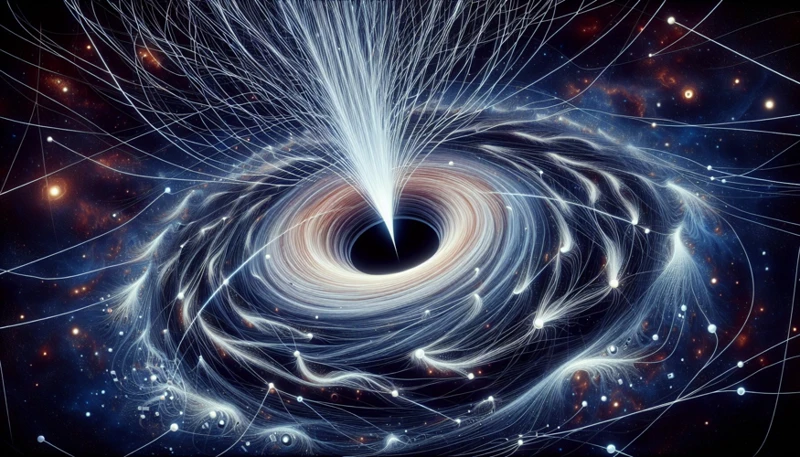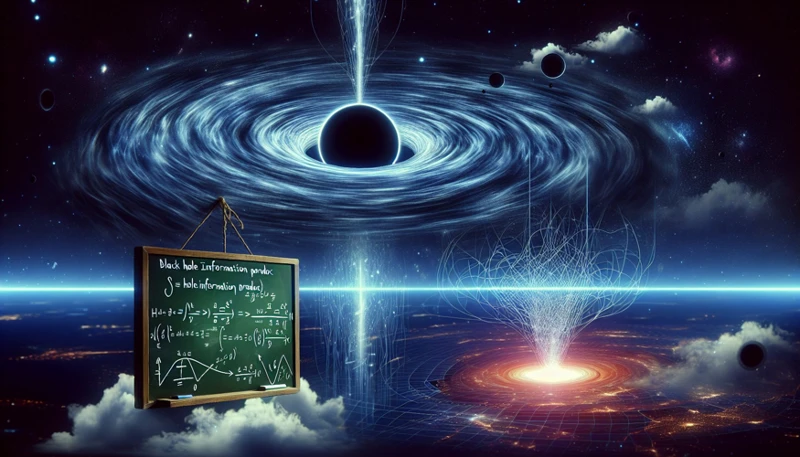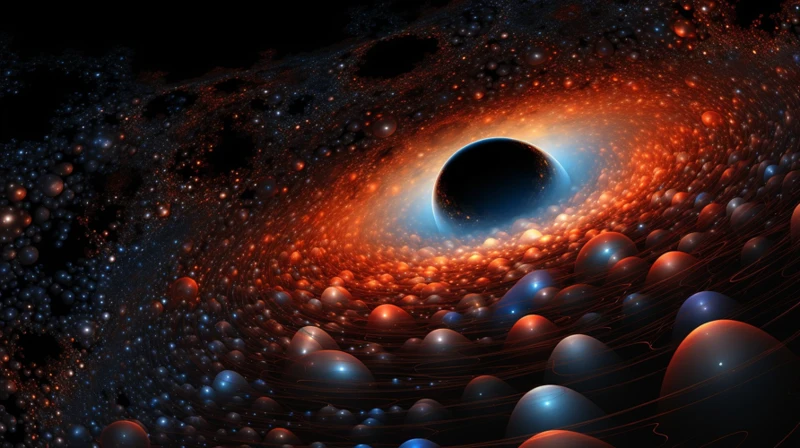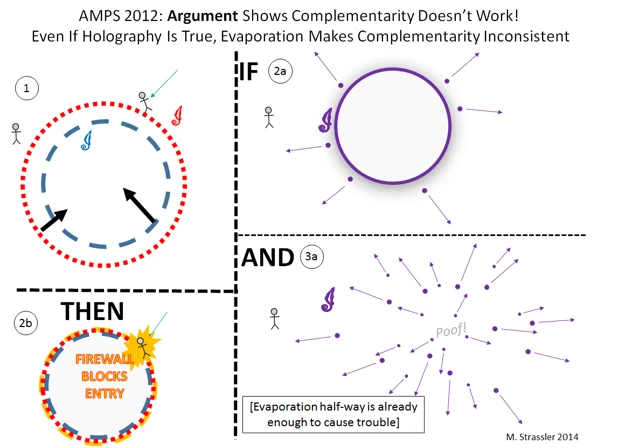The enigmatic realms of black holes have captivated the minds of scientists and enthusiasts alike for decades. These cosmic wonders, born from the death throes of massive stars, possess an incredibly powerful gravitational pull that even light cannot escape. But beyond their gravitational might, black holes hide a profound mystery – the information paradox. As we delve into the depths of this enigma, we will explore the concepts of black hole entropy, the perplexing nature of information loss, the pioneering theories of physicist Stephen Hawking, and the proposed solutions that strive to shed light on the hidden secrets of these celestial enigmas. Join us on this mind-bending journey into the heart of the black hole information paradox.
Contents
- The Nature of Black Holes
- Entropy and the Information Paradox
- The Hawking Radiation Theory
- Resolving the Paradox: The Firewall Hypothesis
- Information Preservation in Black Holes
- Conclusion
-
Frequently Asked Questions
- 1. Are black holes actually holes in space?
- 2. Can anything escape from a black hole?
- 3. Do black holes eventually consume everything in the universe?
- 4. Can black holes merge with each other?
- 5. Are black holes responsible for planetary alignments and wars?
- 6. Can black holes be found in our own galaxy?
- 7. Is it possible to travel through a black hole?
- 8. What is the information paradox?
- 9. Who is Stephen Hawking and what did he contribute to black hole physics?
- 10. What are alternative theories to the information paradox?
- References
-
Frequently Asked Questions
- 1. How are black holes formed?
- 2. What is the event horizon of a black hole?
- 3. What is singularity in the context of black holes?
- 4. What is entropy and how does it relate to black holes?
- 5. What is the information paradox?
- 6. Who is Stephen Hawking and what is his contribution to black hole physics?
- 7. What is Hawking radiation and how does it affect black holes?
- 8. What is the firewall conundrum?
- 9. What are some alternative theories and controversies surrounding the information paradox?
- 10. What are the proposed solutions to the information preservation problem?
- References
- Read More
The Nature of Black Holes

Black holes, the enigmatic cosmic entities forged by the tumultuous demise of massive stars, possess fascinating and perplexing characteristics. Let us embark on a journey to understand the fundamental nature of these celestial phenomena.
Stellar evolution plays a pivotal role in the creation of black holes. When a massive star exhausts its nuclear fuel, gravity collapses its core inward, resulting in an explosive supernova. What remains after this cataclysmic event is a dense core known as a neutron star. However, in cases where the progenitor star is significantly more massive, the gravitational collapse continues relentlessly, giving rise to a black hole. This astonishing cosmic transformation forever alters the fabric of space and time, birthing an object of immense gravitational pull.
At the heart of a black hole lies two critical components – the event horizon and the singularity. The event horizon marks the boundary beyond which nothing, not even light, can escape the gravitational grasp of the black hole. It acts as an “inescapable prison,” confining all matter and light to the confines of its immense gravitational pull. The singularity, on the other hand, is a point of infinite density where the laws of physics as we understand them break down. It is postulated to be a region of extraordinary mass compressed into an infinitesimally small volume. The combination of these two elements shapes the unique and mysterious nature of black holes.
By probing the mysteries of black holes, scientists seek to unravel the secrets of the universe and gain deeper insights into the fabric of spacetime. In the next section, we will explore the perplexing concept of entropy and its connection to the information paradox surrounding black holes.
1. Stellar Evolution and Black Hole Formation
During stellar evolution, the fate of a massive star is governed by a delicate balance between gravity and nuclear fusion. As a star exhausts its nuclear fuel, the outward pressure created by fusion reactions weakens, giving way to the overwhelming force of gravity. This gravitational collapse triggers a cataclysmic event known as a supernova, where the outer layers of the star are expelled into space with tremendous energy.
However, in cases where the initial mass of the star is at least three times greater than that of our Sun, the collapse does not halt with the ejection of the outer layers. Instead, gravity crushes the core of the star into a point of infinite density known as a singularity. This singularity is concealed by an event horizon, which serves as the boundary marking the point of no return for anything that ventures too close to the black hole.
The formation of black holes is a striking consequence of stellar evolution. When a massive star reaches the end of its lifespan, the intense gravitational collapse of its core results in the birth of a black hole. These cosmic entities possess a gravitational force so powerful that their escape velocity exceeds the speed of light, rendering them invisible to the human eye.
But the formation of black holes doesn’t necessarily end with the supernova explosion. In certain scenarios, black holes can merge through a process called black hole mergers, where two or more black holes engage in a violent cosmic dance, spiraling towards each other and eventually combining into a single, more massive black hole. These mergers are believed to occur when black holes are part of a binary system or when galaxies collide.
The understanding of stellar evolution and black hole formation plays a crucial role in unraveling the mysteries of the universe. By studying these extraordinary cosmic phenomena, scientists can delve deeper into the nature of gravity, the behavior of matter under extreme conditions, and the evolution of galaxies. In the next section, we will explore another fascinating aspect of black holes – their event horizon and singularity.
2. Event Horizon and Singularity
The event horizon and singularity are two fundamental aspects that define the intriguing nature of black holes. Let’s delve deeper into these concepts and explore their significance.
Event Horizon: The event horizon is a critical boundary that surrounds a black hole. It represents the point of no return, beyond which nothing can escape the immense gravitational pull. Once an object crosses the event horizon, it is inexorably drawn towards the singularity at the center of the black hole. The event horizon acts as an invisible barrier, trapping everything within its grasp, including light itself. This phenomenon gives black holes their mysterious and captivating allure, as they appear as perfect absorbers of matter and energy.
Singularity: At the heart of a black hole lies the singularity, a region of extreme density and gravitational force. It is a point where the laws of physics break down, and our understanding of the universe reaches its limits. According to general relativity, the singularity is thought to be infinitely dense, with all matter and energy compressed into a single point. However, the singularity is hidden from our direct observation, lurking deep within the black hole’s event horizon. Understanding the nature of the singularity is crucial for resolving the mysteries surrounding black holes and their behavior.
The interplay between the event horizon and singularity gives rise to the extraordinary properties of black holes. As matter and energy fall into the gravitational well, they contribute to the mass and energy of the singularity, perpetuating its immense gravitational pull. The concept of the event horizon and singularity raises intriguing questions about the nature of space, time, and the fate of matter engulfed within these cosmic entities.
In the next section, we will delve into the intricate concept of entropy and its connection to the information paradox associated with black holes.
Entropy and the Information Paradox

Entropy, a concept deeply woven into the fabric of thermodynamics and statistical mechanics, also holds a significant role in understanding the information paradox associated with black holes. In the realm of physics, entropy is a measure of the disorder or randomness within a system. The higher the entropy, the greater the level of disorder. Within the context of black holes, entropy reveals itself as a perplexing puzzle.
Black hole entropy relates to the number of microscopic quantum states that correspond to the macroscopic properties of a black hole. According to the laws of classical physics, a black hole should have zero entropy due to its fundamental nature as a region of extreme gravitational collapse. However, intriguingly, physicist Jacob Bekenstein proposed that black holes possess an entropy directly proportional to their event horizon area, giving rise to the concept of black hole entropy.
This revelation brings forth the information paradox, which arises from the clash between quantum mechanics and classical physics. Quantum mechanics, a realm where information is highly conserved, contradicts the idea of information loss within black holes. According to classical physics and the laws of general relativity, if an object falls into a black hole, it appears that all information about the object is lost forever. This apparent contradiction stirs confusion and challenges our understanding of the fabric of reality.
The resolution of this paradox may lie in the groundbreaking work of physicist Stephen Hawking, which we will explore in the next section. By studying the quantum properties of black holes, Hawking’s theory of Hawking radiation provides a potential mechanism for information retrieval from these cosmic enigmas. Join us as we delve into the depths of Hawking’s revolutionary ideas and the unveiling of the mysterious Hawking radiation.
1. Understanding Entropy
Entropy, a fundamental concept in thermodynamics and information theory, holds the key to understanding the puzzling intricacies of the black hole information paradox. To grasp the notion of entropy, it is essential to explore its connection to disorder and randomness.
In simple terms, entropy can be thought of as a measure of the level of chaos within a system. It quantifies the number of microstates that a system can occupy while maintaining its macroscopic properties. The higher the entropy, the greater the system’s disorder and unpredictability.
In the context of black holes, entropy takes on a remarkable form. The seminal work of physicist Jacob Bekenstein and subsequent contributions from Stephen Hawking revealed that black holes possess a level of entropy that defies conventional understanding. This revelation shook the foundations of physics and raised profound questions about the nature of information and its preservation within black holes.
According to the famous area theorem, the entropy of a black hole is proportional to the surface area of its event horizon. This discovery suggests that black holes can harbor a vast amount of information encoded within their boundaries. However, another principle, known as the holographic principle, challenges this notion by suggesting that the information within a black hole is fundamentally encoded on its two-dimensional surface. These competing ideas lead to the central question of how information within a black hole is preserved or lost.
The debate surrounding black hole entropy and information preservation has fueled intense research and theoretical developments in the field of physics. As scientists strive to unlock the secrets of black holes, they continue to grapple with the paradox that arises from these conflicting principles. In the next section, we will delve deeper into the black hole entropy paradox and the perplexing puzzle it presents for our understanding of the universe.
2. Black Hole Entropy: A Paradoxical Puzzle
Black hole entropy presents a paradoxical puzzle that challenges our understanding of the nature of information. Entropy, a concept borrowed from thermodynamics, describes the measure of disorder or randomness within a system. It is closely tied to the number of microstates that can lead to a given macrostate. In the context of black holes, the concept of entropy becomes particularly intriguing.
According to the laws of thermodynamics, entropy should only increase or remain constant in a closed system. However, when matter falls into a black hole, it appears to vanish from the observable universe, leading to a decrease in entropy. This apparent violation of the entropy law raises the question: what happens to the information contained within the matter that falls into a black hole?
The information paradox revolves around the conflict between the irreversible increase in entropy and the loss of information within black holes. The paradox suggests that information that falls into a black hole is somehow lost to the universe, erasing details of its initial configuration. This contradiction with the laws of physics, particularly those governing information preservation, has perplexed physicists for decades.
Resolving the information paradox is crucial for maintaining the coherence of our understanding of the universe. It requires reconciling the fundamental principles of quantum mechanics and general relativity, which govern the behavior of matter and spacetime at the smallest and largest scales, respectively. Several theories and proposed solutions have emerged, offering potential resolutions to this paradox.
In the upcoming sections, we will delve into the pioneering work of physicist Stephen Hawking and his groundbreaking theory of Hawking radiation, which holds promise in shedding light on the mystery of black hole entropy and information preservation. Prepare to embark on a fascinating journey into the realms of black hole physics and unravel the secrets that lie within these cosmic enigmas.
The Hawking Radiation Theory

The Hawking Radiation Theory, proposed by the renowned physicist Stephen Hawking, revolutionized our understanding of black holes. According to this groundbreaking theory, black holes are not entirely black, but instead emit a faint radiation known as Hawking radiation.
To comprehend the Hawking Radiation Theory, we must delve into the realm of quantum physics. Quantum mechanics introduces the notion of virtual particles continuously popping in and out of existence in empty space. Hawking proposed that when a pair of these virtual particles is created near the event horizon of a black hole, one particle may fall into the black hole while the other escapes into space. This process, known as particle-antiparticle pair production, leads to a gradual loss of mass by the black hole.
Hawking radiation has profound implications as it suggests that black holes are not eternal, but instead have a finite lifespan. Over time, the black hole loses mass and ultimately evaporates, releasing energy in the form of the emitted particles. This concept challenges the long-held belief that nothing can escape a black hole’s gravitational pull.
The discovery of Hawking radiation sparked a paradigm shift in our understanding of black holes and their inherent connection to the laws of quantum mechanics. It also unveiled a potential solution to the information paradox – the puzzle of what happens to information that falls into a black hole.
However, the Hawking Radiation Theory is not without controversy. Scientists continue to debate its implications, including its compatibility with other fundamental theories of physics such as general relativity. In the next section, we will explore the conundrum of the information paradox and the proposed resolution known as the Firewall Hypothesis.
1. Stephen Hawking: A Trailblazer in Black Hole Physics
Stephen Hawking, a renowned physicist, made groundbreaking contributions to our understanding of black holes and their mysterious properties. Despite his battle with amyotrophic lateral sclerosis (ALS), Hawking’s intellectual prowess soared, propelling him to become one of the most influential scientists of his time.
One of Hawking’s most significant achievements was his formulation of the theory of Hawking radiation. According to classical physics, nothing can escape the clutches of a black hole, not even light. However, Hawking theorized that black holes are not entirely devoid of emission. Through a complex interplay of quantum mechanics and general relativity, he proposed that black holes could emit particles and energy over time. This revolutionary idea challenged the long-held belief that black holes were completely inhospitable and forever consuming.
Hawking’s work on black hole evaporation and the subsequent release of energy in the form of radiation caused a seismic shift in the field of black hole physics. It provided a profound link between the realms of quantum mechanics and gravity, merging two previously incompatible theories. In recognition of his contributions, this theoretical radiation emitted by black holes is now famously known as Hawking radiation.
This groundbreaking work by Hawking not only revolutionized our understanding of black holes but also had profound implications for the concept of black hole entropy and the information paradox. In the next section, we will unravel the intricate web surrounding black hole entropy and the enigma it presents.
2. Unveiling the Hawking Radiation
Stephen Hawking, renowned physicist and visionary thinker, made a groundbreaking contribution to our understanding of black holes with his revolutionary theory of Hawking Radiation. This theory proposed that black holes are not entirely black after all – they slowly emit particles over time, a phenomenon now known as Hawking Radiation.
Hawking’s theory challenged the long-held belief that nothing could escape the gravitational pull of a black hole, including light. He combined the principles of quantum mechanics and general relativity to explain this paradox. According to quantum mechanics, particles spontaneously appear and annihilate in empty space. Hawking theorized that near a black hole’s event horizon, these particle-antiparticle pairs would be split. One particle would fall into the black hole while its antiparticle counterpart would escape into space.
This process, known as particle pair production, would appear as radiation emanating from the black hole. The energy for this radiation is derived from the black hole itself, leading to its gradual loss of mass and eventual evaporation. Hawking Radiation revolutionized the field of black hole physics, providing a mechanism for black holes to lose mass and information over time.
The implications of Hawking Radiation are profound. It suggests that black holes have a finite lifespan, eventually evaporating into nothingness. This challenges the notion of black holes as eternal cosmic prisons. It raises questions about the fate of the information contained within a black hole – does it disappear along with the black hole, or is it somehow encoded in the radiation emitted through Hawking Radiation?
The concept of Hawking Radiation provides a potential solution to the information paradox and opens up new avenues for exploring the mysteries of black holes. However, the precise nature of this radiation and its connection to the preservation of information remains a topic of ongoing research and debate. In the next section, we will delve deeper into the controversy surrounding the information paradox and the potential resolutions proposed by scientists.
Resolving the Paradox: The Firewall Hypothesis

The Firewall Hypothesis is a proposed solution to the black hole information paradox, which suggests that the event horizon of a black hole might actually be a seething wall of high-energy particles, akin to a scorching firewall. This hypothesis challenges the previously held belief that crossing the event horizon would be a relatively benign experience due to the concept of complementarity. According to complementarity, an observer falling into a black hole would not experience anything unusual, while an outside observer would perceive them as being stretched and ultimately torn apart by the black hole’s immense gravitational forces. However, the Firewall Hypothesis posits that instead of a gentle passage through the event horizon, an infalling observer would be instantaneously incinerated by the intense energy at the firewall, a concept that runs counter to the principles of general relativity and quantum mechanics.
This controversial hypothesis seeks to resolve the information paradox by suggesting that the horizon of a black hole is not a passive boundary but an active region where particles and their corresponding information become entangled. This apparent violation of established physical principles has sparked intense debate among physicists, as it challenges our understanding of fundamental concepts like the equivalence principle and unitarity. Some researchers believe the firewall hypothesis provides a resolution to the information paradox, while others consider it an indicator of a deeper conceptual problem in our current understanding of black holes and quantum gravity.
Despite its controversial nature, the Firewall Hypothesis has opened up new avenues for exploring the fundamental nature of black holes and the preservation of information within them. It has spurred further investigations into alternative theories, such as fuzzballs and the ER=EPR conjecture, which offer alternative explanations for black hole entropy and the fate of information. The quest to unravel the mysteries of black hole physics and information preservation continues, as scientists delve deeper into the cosmic dance of these enigmatic objects.
Next, we will explore the role of quantum mechanics in understanding information preservation in black holes.
1. The Firewall Conundrum
The Firewall Conundrum presents a formidable challenge to our understanding of black holes and the preservation of information within them. According to classical physics, an observer falling into a black hole would experience a smooth passage through the event horizon, ultimately succumbing to the singularity at the center. However, quantum mechanics introduces a new layer of complexity. The principle of unitarity states that information cannot be destroyed in a quantum system. This principle clashes with the classical notion of black holes as information sinks, leading to a paradox. The Firewall Hypothesis emerged as a controversial attempt to resolve this paradox. It proposes that just before an object crosses the event horizon, a high-energy firewall forms, incinerating any incoming matter and ensuring the preservation of information. However, the existence of such a firewall raises questions about the consistency of our current understanding of spacetime and the principles of general relativity. Scientists continue to grapple with this paradox, seeking alternative explanations and theories that can harmonize quantum mechanics with the classical physics of black holes.
2. Alternative Theories and Controversies
Alternative theories and controversies surrounding black holes have sparked intense debate among physicists and scientists. While the firewall hypothesis aims to resolve the information paradox by proposing the existence of a thin but highly energetic barrier near the event horizon, it has faced criticism and skepticism. Critics argue that the firewall violates the principles of quantum mechanics and general relativity, raising concerns about the consistency of this hypothesis with the laws of physics. Some researchers have put forward alternative theories, such as the fuzzball theory, which suggests that black holes are not truly singularities but rather collections of strings or other exotic matter. These theories strive to provide a more comprehensive understanding of black holes and their behavior, but they too face challenges and open questions. The study of black holes continues to evolve, with ongoing research exploring the intricacies of these cosmic enigmas. By unraveling the mysteries of black holes, scientists hope to gain deeper insights into the nature of gravity, quantum mechanics, and the fundamental workings of the universe.
Information Preservation in Black Holes

Moving further into the depths of the black hole information paradox, we encounter the intriguing topic of information preservation within these cosmic enigmas. At the heart of this mystery lies the interplay between black holes and quantum mechanics.
Quantum mechanics, the realm of physics that governs the behavior of particles at the smallest scales, introduces a new perspective on information. In this framework, information is not lost but entangled with the particles that make up the black hole. This concept challenges the traditional understanding of black holes as information devourers.
Proposed solutions attempt to reconcile the conundrum of information preservation. One intriguing idea is the concept of “black hole hair.” Similar to how hair gives individuals their unique characteristics, black hole hair hypothesizes that black holes possess distinct quantum properties that encode the information of matter that fell into them. These properties would be preserved on the event horizon, allowing for later retrieval.
Another proposed solution comes in the form of holography. This concept suggests that the information swallowed by a black hole is not destroyed or lost but rather imprinted on its event horizon, like a hologram. According to this theory, three dimensions of space within the black hole correspond to a two-dimensional representation on its surface.
While these theories present potential avenues for reconciling the information paradox, further exploration and research are needed to unravel the true nature of information preservation in black holes. The next section will delve into the conclusions and implications that arise from our quest to understand these cosmic enigmas and their information-dense interiors.
1. The Role of Quantum Mechanics
The enigmatic behavior of black holes, such as their ability to seemingly violate the laws of thermodynamics, invites us to explore the role of quantum mechanics in understanding these cosmic phenomena. Quantum mechanics, the branch of physics that governs the behavior of subatomic particles, plays a pivotal role in unraveling the mysteries of black hole physics.
At the heart of quantum mechanics lies the concept of uncertainty, encapsulated in Heisenberg’s uncertainty principle. This principle asserts that fundamental properties of particles, such as position and momentum, cannot be precisely determined simultaneously. In the context of black holes, this principle becomes crucial in understanding the behavior of particles near the event horizon.
According to quantum mechanics, particles can also exist in a probabilistic state, described by a wave function. This wave function represents the probability distribution of the particle’s properties. When a particle crosses the event horizon of a black hole, it is subjected to immense gravitational forces. Quantum mechanics suggests that these forces can cause the particle’s wave function to become entangled with the black hole’s quantum state.
This brings us to the concept of Hawking radiation, proposed by physicist Stephen Hawking. According to Hawking’s theory, black holes are not completely black, but rather emit a faint radiation due to quantum effects. This phenomenon arises from the entanglement between particles and their antiparticles at the event horizon. The energy needed to sustain this entanglement is borrowed from the black hole’s mass, leading to its eventual evaporation.
The role of quantum mechanics in the context of black holes is crucial as it promises to shed light on the mysterious connection between gravity and quantum physics – two fundamental frameworks of the universe. By delving deeper into the quantum nature of black holes, scientists hope to reconcile the paradoxes and uncover new insights into the fundamental nature of spacetime. In the following section, we will explore proposed solutions such as black hole hair and holography that aim to preserve information within black holes.
2. Proposed Solutions: Black Hole Hair and Holography
Proposed solutions to the information paradox that plagues black holes have sparked intense debate and speculation within the scientific community. Two prominent ideas that have gained traction are the concepts of “black hole hair” and holography.
Black hole hair refers to the notion that black holes may possess additional quantum properties, also known as “hair,” which could encode and retain information. This idea suggests that black holes are not completely featureless entities but rather harbor subtle characteristics that hold valuable insights into the preservation of information. While the specifics of black hole hair remain speculative, it offers a potential avenue for resolving the paradox by challenging the long-held belief that black holes are devoid of any distinguishing features beyond their mass, charge, and angular momentum.
Holography, on the other hand, takes inspiration from the peculiar principles of quantum mechanics and suggests that the information within a black hole may be projected onto its boundary, known as the event horizon. This concept, known as the holographic principle, posits that the description of the interior of a black hole can be encoded as a two-dimensional “hologram” on its surface. It suggests that the complexity and entropy associated with the black hole’s interior can be understood solely by analyzing the information stored on its boundary. This radical idea has strong connections to string theory and has the potential to shed light on the nature of black hole entropy and information preservation.
While both black hole hair and holography offer intriguing possibilities for reconciling the information paradox, further research and experimentation are crucial to validate these hypotheses. The exploration of these proposed solutions continues to fuel the curiosity and inquisitiveness of scientists worldwide, as they pursue a deeper understanding of the enigmatic nature of black holes. In the next section, we will draw this captivating journey to a close and summarize the key insights gained from our exploration of the black hole information paradox.
Conclusion

As we conclude our exploration of the black hole information paradox, we are left with more questions than answers. The nature of black holes, with their immense gravitational pull and mysterious event horizons, continues to astonish and perplex scientists and enthusiasts alike. The concept of entropy and its connection to black holes deepens the puzzle. The groundbreaking work of physicist Stephen Hawking and his theory of Hawking radiation shed light on the potential mechanisms for information preservation in black holes. However, the paradox is far from resolved, as alternative theories and controversies, such as the controversial firewall hypothesis, continue to challenge our understanding.
The role of quantum mechanics in unraveling the secrets of black holes cannot be overstated. Concepts like black hole hair and holography offer potential solutions to the information paradox and further our grasp of the complex interplay between quantum mechanics and gravity.
Despite the ongoing research and theoretical advancements, the question of how information is preserved within the depths of a black hole remains unanswered. The exploration of the information paradox pushes the boundaries of our understanding of the universe and provokes new ways of thinking about the fundamental laws of physics.
In conclusion, black holes stand as cosmic mysteries, captivating our imagination and challenging our scientific knowledge. The quest to comprehend their nature and unravel the secrets they hold continues to push us towards new frontiers of knowledge. Whether through the study of entropy, the exploration of Hawking radiation, or the pursuit of alternative theories, the enigma of black holes persists, beckoning us to delve deeper into the mysteries of our universe.
Frequently Asked Questions

1. Are black holes actually holes in space?
No, black holes are not physical holes in space. They are regions of spacetime with extremely strong gravitational forces and infinite density at their centers.
2. Can anything escape from a black hole?
Once something crosses the event horizon of a black hole, it is believed to be trapped inside and cannot escape. This includes matter, light, and even information.
3. Do black holes eventually consume everything in the universe?
No, black holes do not consume everything in the universe. Their gravitational pull only affects objects that come within their vicinity. The vast majority of the universe remains unaffected by black holes.
4. Can black holes merge with each other?
Yes, black holes can merge with each other in a violent cosmic dance. This phenomenon, known as black hole mergers, occurs when two black holes come close enough to each other and their gravitational forces cause them to orbit and eventually merge into a single, more massive black hole.
5. Are black holes responsible for planetary alignments and wars?
No, black holes are not responsible for planetary alignments or wars. Planetary alignments are natural phenomena that occur due to the gravitational interactions between celestial bodies. Wars, on the other hand, are human conflicts that have no direct connection to black holes.
6. Can black holes be found in our own galaxy?
Yes, there are black holes known to exist in our Milky Way galaxy. One well-studied black hole is located at the center of our galaxy, known as Sagittarius A*.
7. Is it possible to travel through a black hole?
The possibility of traveling through a black hole remains purely speculative. The extreme gravitational forces and unknown nature of the singularity make it highly unlikely that any object or information could survive the journey.
8. What is the information paradox?
The information paradox is a concept that arises from the apparent conflict between the principles of quantum mechanics and the theory of general relativity. It questions what happens to the information that enters a black hole and whether it is preserved or lost.
9. Who is Stephen Hawking and what did he contribute to black hole physics?
Stephen Hawking was a renowned physicist who made significant contributions to the field of black hole physics. His groundbreaking work on Hawking radiation revolutionized our understanding of how black holes interact with and emit particles over time.
10. What are alternative theories to the information paradox?
There are several alternative theories that attempt to address the information paradox. Some propose the existence of “firewalls,” while others explore concepts like black hole “hair” or the holographic principle as possible solutions to reconcile the conflicting principles of quantum mechanics and general relativity.
References
- Black hole information paradox
- The black hole paradox that thwarts our understanding of …
- Black Holes and the Information Paradox in String Theory
Frequently Asked Questions

1. How are black holes formed?
Black holes are formed through a process known as stellar evolution. When a massive star exhausts its nuclear fuel, it undergoes a supernova explosion, leaving behind a dense core. If this core has a mass greater than about three times the mass of our Sun, it collapses under its own gravity, forming a black hole.
2. What is the event horizon of a black hole?
The event horizon is the boundary surrounding a black hole from which nothing, not even light, can escape. Once an object crosses the event horizon, it is forever trapped within the gravitational pull of the black hole.
3. What is singularity in the context of black holes?
Singularity refers to the infinitely dense and compressed mass at the center of a black hole. It is a point of extreme gravitational force where the laws of physics, as we currently understand them, break down.
4. What is entropy and how does it relate to black holes?
Entropy is a measure of the disorder or randomness in a system. In the context of black holes, entropy plays a crucial role in understanding the information paradox. It helps quantify the number of microstates corresponding to a given macrostate of a black hole.
5. What is the information paradox?
The information paradox is a puzzle that arises due to the conflict between the principles of quantum mechanics and general relativity. It questions what happens to the information of matter that falls into a black hole, as it seems to violate the principle of information preservation.
6. Who is Stephen Hawking and what is his contribution to black hole physics?
Stephen Hawking was a renowned physicist who made significant contributions to our understanding of black holes. His work on the Hawking radiation theory revolutionized the field and led to groundbreaking insights into the thermodynamics of black holes.
7. What is Hawking radiation and how does it affect black holes?
Hawking radiation is a theoretical prediction by Stephen Hawking that suggests black holes are not entirely black, but instead emit radiation due to quantum effects near the event horizon. This radiation carries away energy from the black hole, causing it to gradually lose mass and eventually evaporate over an extremely long timescale.
8. What is the firewall conundrum?
The firewall conundrum is a paradox that arises when attempting to reconcile the principles of quantum mechanics, general relativity, and black holes. It questions the smoothness of the event horizon and proposes the existence of a firewall, a region of intense energy, at the event horizon that would violate our understanding of physics.
9. What are some alternative theories and controversies surrounding the information paradox?
Several alternative theories have been proposed to address the information paradox, including the fuzzball and firewall hypotheses. These theories suggest new ideas about the structure of black holes and challenge traditional notions of event horizons and singularities. The scientific community continues to debate and explore these ideas to unravel the mysteries of black holes.
10. What are the proposed solutions to the information preservation problem?
Two notable solutions proposed to tackle the information preservation problem are the “black hole hair” and holography theories. The black hole hair theory suggests that black holes may possess long-lasting remnants or subtle traces of information that are not destroyed. Holography, on the other hand, proposes that the information of particles falling into a black hole is encoded on its two-dimensional surface.







